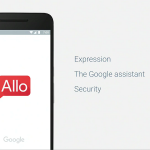As usual, Google always has some surprise in store for the Google I / O and there is always an atmosphere conducive mystery about the fate of some of its services. After years with Hangouts app bedside chat and video calls in June they had Allo and Duo, two new apps for communication.
A few months later, we had a chance to try Duo, the app for video calls and a priori that appeared to be a tool for such use without much added and utilities. What enables Duo and how does it work? We’ll tell you in detail.
Based on the simple and familiar
The foundation of this new app of Mountain View is just that: it is a simple app for video calls, uncomplicated and it is understood the first by any user regardless of platform and their prior knowledge. Thus, the interface consists only of a main screen from which the video call is made, with the options menu to display from the top right corner.

Indeed make a video call is extremely easy : from the outset have the option to go to the contact list, so will we first those with the installed app , and then those who do not have it, with the alternative to invite from the same contact. In fact, something that distinguishes it from Hangouts video calling and other services is that only ask for the phone number and not an email.
Activation makes just as WhatsApp, requesting a code of six digits that we receive by SMS. In the case of the iOS app we have had a slight lag here (by not putting well and try to correct number was not clear in what space was the cursor) but we were able to activate it without problems. A collation of this moment the app is available for iOS and Android.
In any type of network and calling before entering
Once we have, the service activated can call contacts that also have it with one or two taps, regardless of what type of network we find ourselves and the recipient (WiFi or data). In the case of Android, the receiver seems typical call interface; while in the case of iOS depend on whether or not we have the unlocked screen and the app in the foreground, appreciation in any case except the last notification.
It is from the screen or from the notification, which can be activated is the Toc Toc function, which allows you to view a preview of the caller before accepting the call. This is something we have previously enable communication if desired and it only works with people who have in the contact list, and that at the moment can only be enabled in Android by system limitations.
What happens if during the call signal type change? In that case we will experience a small cut either the audio or the video signal due to the change. Usually it stabilizes in a few seconds, depending on which network we (and worse the longer it takes audio and image quality have the less coverage or WiFi signal). If there is not enough to support the video call, a warning will appear us and only we will keep the audio (and our own issue).
You may also like to read another article on FreshLookApp: Allo is the best messaging application to speak only
Within the simplicity they want here, during the call we make rather few actions: display exchange, so that we see on the big screen not our image and our partner, and eliminate audio. The little that can be adjusted well this is done prior or subsequent way in the settings menu (Toc Toc activation and reduced spending data.
The quality of the audio and image ultimately depend on the signal. When it is very good quality both video and audio is high, with only a slight delay in the audio. If we lose coverage either WiFi or image data starts to pixelate and we can have a short break in the audio, as happens regularly in this situation.
You to you and unadorned
Thus, Google makes a move to the basics in relation to video calls, launching this easier than Hangouts time and in parallel with the same app. In fact, it Duo exclusively for calls between two people, no group video calls.
Calls are encrypted end – to – end (can block users), and have a duration of 30 seconds until the person receiving off – hook. As for the requirements of the device is required at least Jelly Bean in the case of Android and iOS 9 in Apple’s case, and in relation to consumption data when making video calls without WiFi can see the Duo.
The app works well, finding some specific flaws in iOS as the notice of the call (or slow to sound, vibrating before we exited or no notification). It will be interesting to see what Google does with new services and old in terms of communications, because although Duo is its new proposal for video calls as we seek to be something much simpler and therefore has a more limited use.


